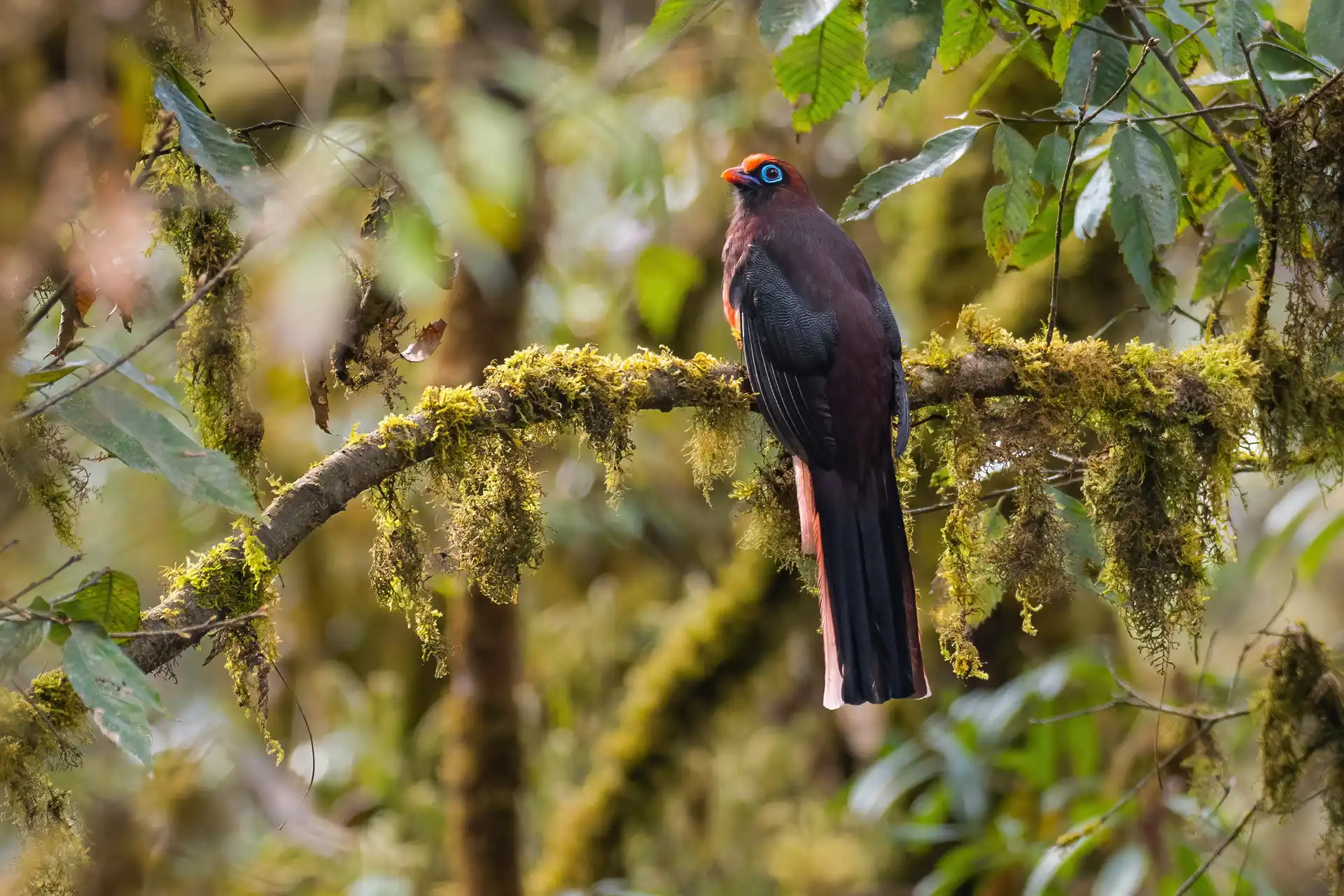
Bhutan: Birding in the Himalayas
- Next tour dates March 26 – April 10, 2026
- Duration 16 days
- Lodging 3-4 stars
- Difficulty Easy – Medium
- Group size Max. 8 people
- Price USD $7,150 per person*
Overview
Bhutan is the next up-and-coming birding destination of Southern Asia. Land-locked by the mighty Himalayas to the north and the Indian Subcontinent to the south, the extensive forests and protected areas create a haven for birds. Bhutan’s quality infrastructure allows access to many of its national parks and premier birding areas, from subtropical lowland forests to high alpine regions at 4,500m and everything in between. An impressive 680 species of birds have been recorded in this small country.
We will start our exciting Bhutan birding tour near the southeastern end of the country, then traverse westward across central Bhutan, birding all the way. During our 16-day tour, we can expect to see 300-350 species of birds including Ruby-cheeked Sunbird, Asian Fairy Bluebird, Ward’s Trogon, and Blood Pheasant. There will also be great possibilities to see the rare Rufous-necked Hornbill and spectacular Satyr Tragopan! Along with so many marvelous birds, we will also revel in the colorful culture of Bhutan through visits to some of the country’s most famous monasteries and museums.
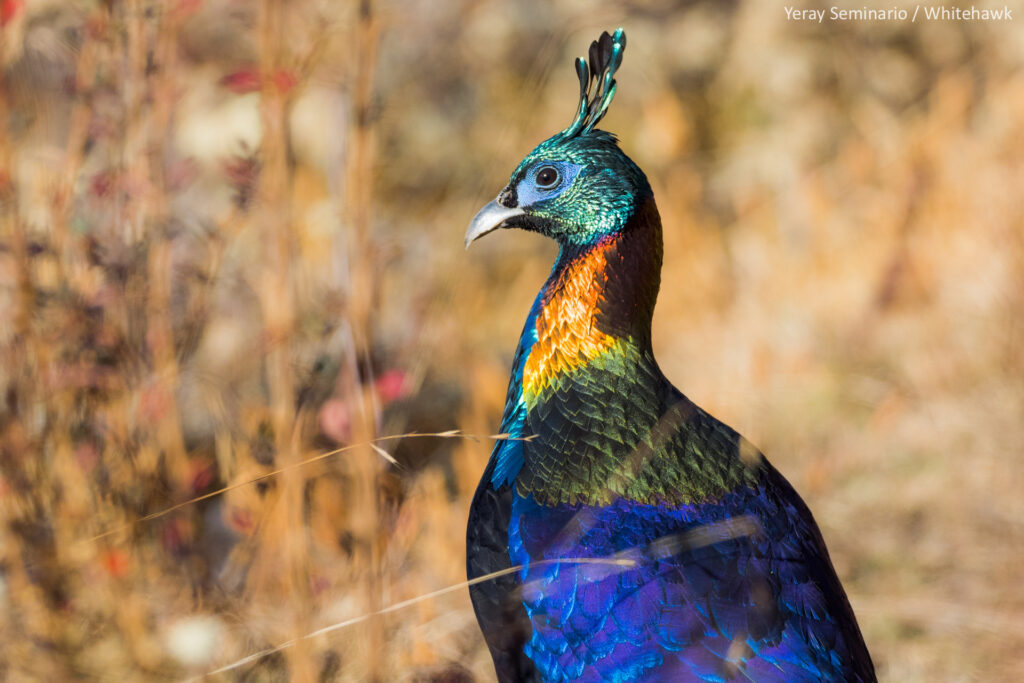
Itinerary
DAY 1: DELHI TO PARO & THIMPHU
Welcome to the Kingdom of Bhutan, the land of the Thunder Dragon! Our tour will start with a flight from Delhi (India) to Paro. From the flight we should have good views of the Himalayan Mountains, including many of the highest peaks in the world. Today we will drive along the Pa Chhu (Paro River), where Ibisbill, a Himalayan riverine species, can be seen camouflaged amongst the glacial stones as it dips in the snowmelt, searching for food. In this area we should also find Blue Whistling-Thrush, Plumbeous Redstart, Chestnut-crowned Laughingthrush, Brown Parrotbill, and Chestnut-tailed Minla. After birding along the Pa Chhu, we will continue to Thimphu for the night. Overnight in Thimphu.
DAY 2: THIMPHU TO PUNAKHA
We will depart before dawn to see the sun break over the Himalayas at Dochu La Pass (3,116 m). In Bhutan’s high elevation mixed evergreen and broadleaf forests, there is an incredible diversity of birds, mammals, and flowering plants. Here it is possible to see species such as Fire-tailed Myzornis, Mrs. Gould’s and Green-tailed sunbirds, Fire-breasted Flowerpecker, and Green Shrike-Babbler around the beautiful blossoms of the Rhododendron bushes. We will continue down through the sub-tropical forests around Punakha where there are cactus, poinsettia and banana plants, then down to the green terraced fields of Punakha. Along the Puna Tshang Chhu (river) we will look for Crested Kingfisher and the scarce Pallas’ Fish-Eagle. Overnight in Punakha.
DAY 3: YAMEY GOENBA & PUNAKHA DZONG
Today we will rise early to drive up to Yamey Goenba, stopping along the Talo and Nobgang villages en route. Along this journey, we will look for the rare Ward’s Trogon, Himalayan Cutia, Hoary-throated Barwing, Kalij Pheasant, Chestnut-headed Tesia, and more. We will return to Punakha in the afternoon to visit the dzong, where we will get a glimpse of Bhutanese religion and culture. Overnight in Punakha.
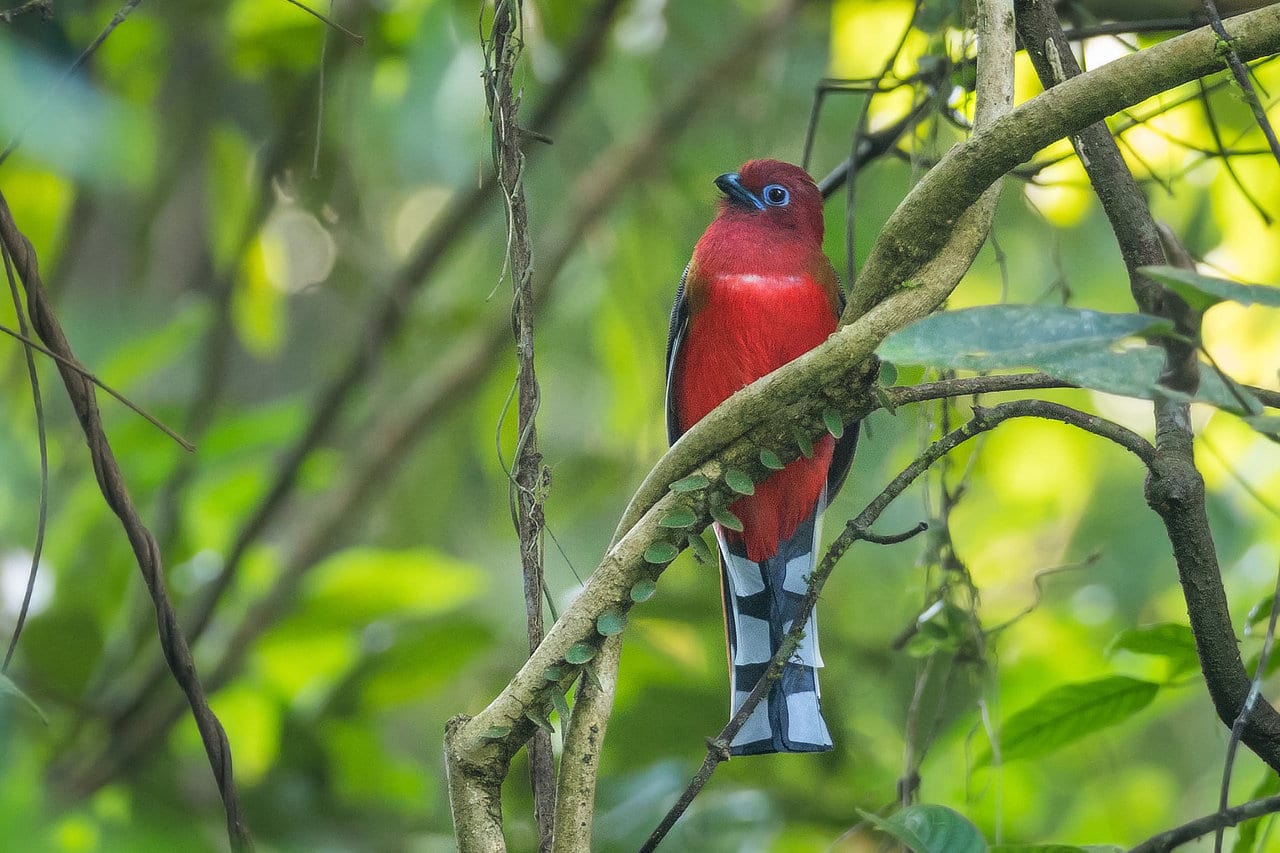
DAY 4: PUNAKHA TO PHOBJIKHA
Today we make our way to Phobjikha, stopping along the bird rich forests of Khelekha, Nobding village, and Lawa La Pass at 3,350 m. The forests here are superb and we will comb the areas for birds such as Rufous-chinned Laughingthrush, Black-eared Shrike-Babbler, Fire-capped Tit, and Greater and Lesser yellownapes. We will climb up through mixed forests ablaze with flowering rhododendrons, to the pass at Pele La (3,390 m). Birding along the pass we should find Great Parrotbill, Crimson-browed Finch, the brilliant Spotted Laughingthrush, and Himalayan Vultures, which can often be seen soaring in the skies above Pele La. We will continue our journey to Phobjikha, descending through the beautiful rhododendron forests and thickets of dwarf bamboo where we will stop to bird, looking for Black-faced Laughingthrush, Stripe-throated Yuhina, and Hume’s Bush Warbler. Overnight in Phobjikha.
DAY 5: PHOBJIKHA TO BUMTHANG
This morning we will gradually make our way up to Pele La Pass (3,350m). Some species that are regularly seen here include Rufous-vented Yuhina, Bhutan Laughingthrush, Rufous-bellied Woodpecker, and White-winged Grosbeak. Descending through silver fir and spruce forests we come to the upland valleys of Chumey, the religious heartland of Bhutan. Bumthang is the only place in Bhutan where we can find the Black-rumped Magpie amongst flocks of noisy Red-billed Chough, which often can be seen feeding in nearby buckwheat fields. If time permits, we will make a short visit to Tharpaling Monastery, hoping to see the colorful Himalayan Monal. Other regular birds here include Snow Pigeon, Altai Accentor, White-throated Redstart, and Himalayan Beautiful Rosefinch. Overnight in Bumthang.
DAY 6: BUMTHANG TO YONGKOLA
Today’s drive is considered to be one of the most spectacular in all of the Himalayas! Lying in the shadow of Thrumshing La, Ura is quite a prosperous village. In the surrounding fields we may encounter flocks of Russet Sparrow, Dark-rumped Rosefinch, Upland Buzzard, and White-browed Rosefinch. Leaving Ura, we climb through evergreen forests until we reach Thrumshing La (3,780 m). Along this magnificent stretch road we look for Blood Pheasant feeding by the roadside. Species we may encounter include Ultramarine Flycatcher, Mountain Hawk-Eagle, Himalayan Bluetail, and Rufous-bellied Niltava. From Thrumshing La, we descend to warmer Yongkola, driving through truly pristine forest where Spanish moss drips from the trees. Here along this drive we will also look for the rare Satyr Tragopan, which can be seen often feeding by the roadside. Overnight in Yongkola.
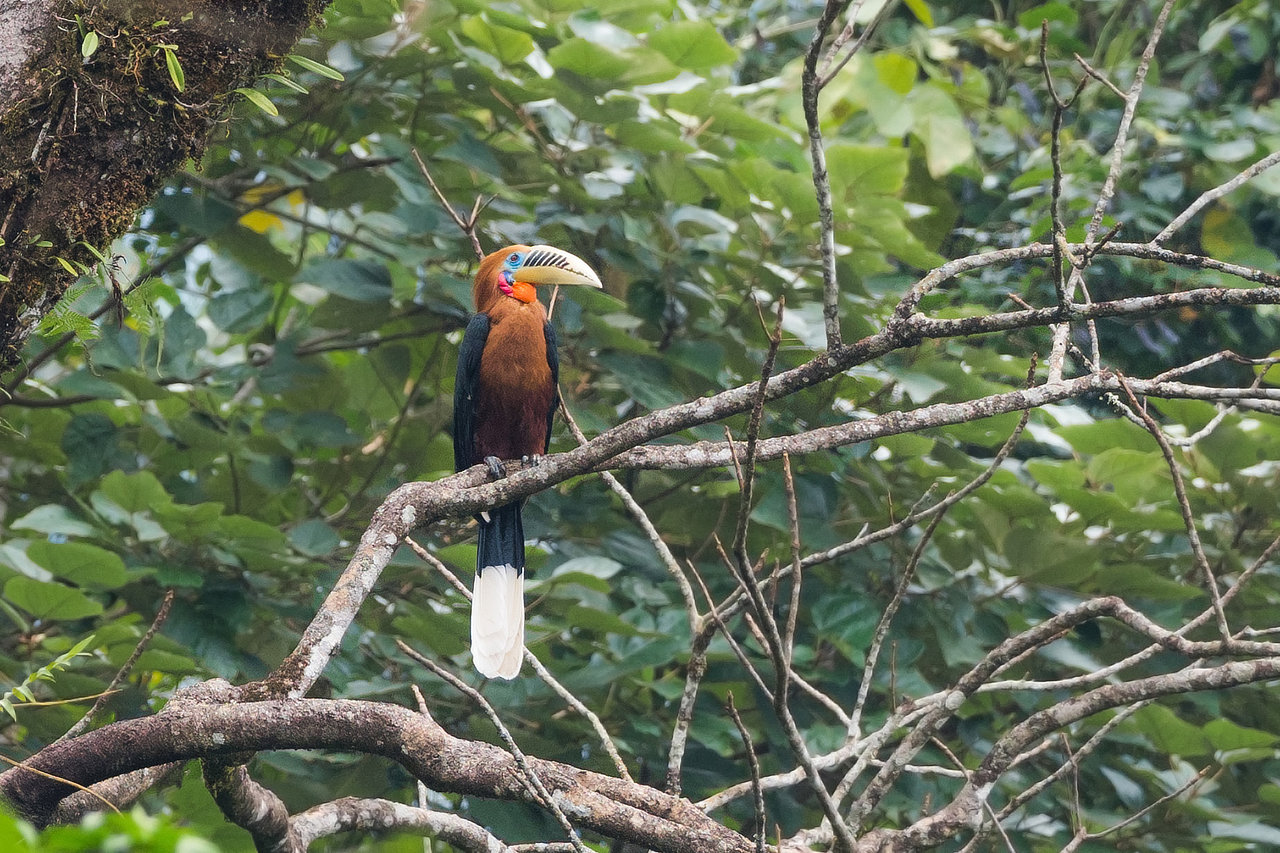
DAY 7: THRUMSHING LA NATIONAL PARK
Thrumshing La National Park is known as one of the best birding spots in all of Asia! We have the full day to explore the upper and lower Yongkola region. In this breathtaking landscape we will bird in a protected area of pristine forest using a paved yet rarely traveled road. Here we will look for some of Bhutan’s most prized species, including Fire-tailed Myzornis, Golden-breasted Fulvetta, Rufous-necked Hornbill (the forests of Bhutan are the stronghold for this impressive species), and Ward’s Trogon. Two of the Himalaya’s rarest birds, the cobalt Blue-fronted Robin, and the elusive and strange Sikkim Wedge-billed Babbler, are also found here. Overnight in Yongkola.
DAY 8: YONGKOLA TO PANBANG
Today’s route will take us from Yongkola to Panbang, as we decrease in elevation we will pass through various areas best known for birds and butterflies. Top birds in the area include Rufous-bellied Eagle, Ashy Bulbul, Spangled Drongo and more. We will continue to descend to Nganglam, stopping en route as birding opportunities arise. Nganglam is at 400 meters elevation and we will look for tropical birds including some of the rarest birds found in Bhutan such as the shy Collared Treepie, Blyth’s Kingfisher, and Black-backed Forktail. We will stop along the Yangbari and Norbugang valleys to look for Red-headed Trogon, Wreathed Hornbill, Silver-breasted Broadbill, Greater Necklaced Laughingthrush, and Chesnut-breasted Partridge. Overnight in Panbang.
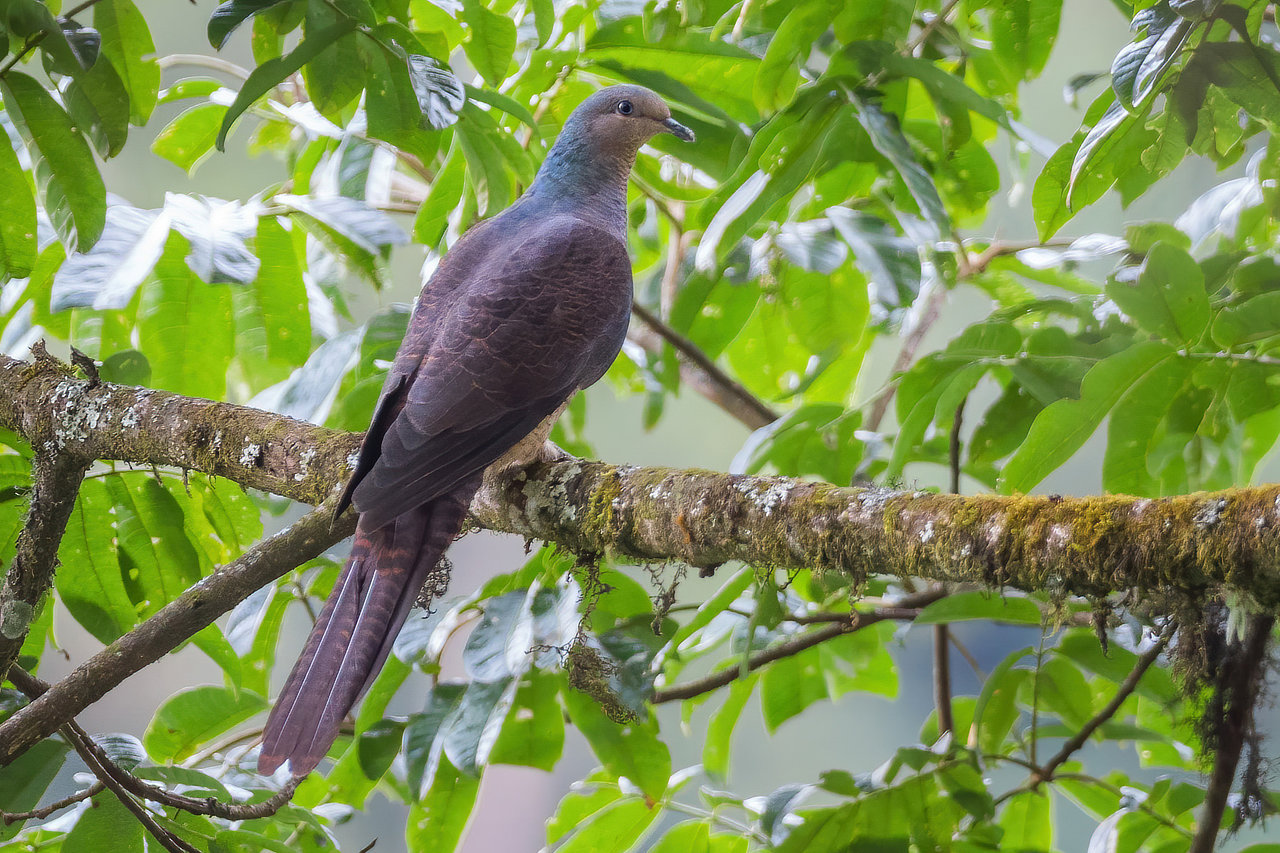
DAY 9: ROYAL MANAS NATIONAL PARK
We will spend the day exploring Royal Manas National Park, a unique UNESCO World Heritage Site and one of the oldest protected areas in Bhutan. We will bird the route from Panbang to the park office at Manas, where we will look for Gray Peacock-Pheasant, Black-backed (Oriental) Dwarf-Kingfisher, Red-breasted Parakeet, Chestnut-headed Bee-eater, Oriental Pied-Hornbill, Great Hornbill, and Hooded Pitta (rare) are amongst the many that frequent this ancient landscape. We will keep an eye out for mammals – Asian Elephant, Water Buffalo, Sambar, Large Indian Civet, Malayan Giant Squirrel, and Capped Langur can all be found in the area. Overnight in Panbang.
DAY 10: PANBANG TO TINGTIBI
Today we will spend most of the morning exploring the Panbang valley for birds and butterflies, and after breakfast we will continue to Tingtibi, making further stops along the Mangdi Chhu valley. Birds we will seek out today include Green-billed Malkoha, Collared Falconet, Ashy Drongo, Changeable Hawk-Eagle, Tawny Fish-Owl, Rufous-throated Partridge, and Sultan Tit. We should also find groups of the endangered Gee’s Golden Langurs along the roadside forests. Overnight in Tingtibi.
DAY 11: SUBTROPICAL FORESTS OF TINGTIBI
The magnificent and very rarely visited Shemgang Road is one of the most beautiful and peaceful roads in the world. Here we can see an amazing variety of rare and special birds as well as Gee’s Golden Langurs. Some of the target birds of the day include Pale-headed Woodpecker, Barred Cuckoo-Dove, Blue-bearded Bee-eater, Long-tailed Broadbill, Rufous-headed Parrotbill, and the rare Beautiful Nuthatch. We also hope for stunning views of Rufous-necked Hornbills! Overnight in Tingtibi.
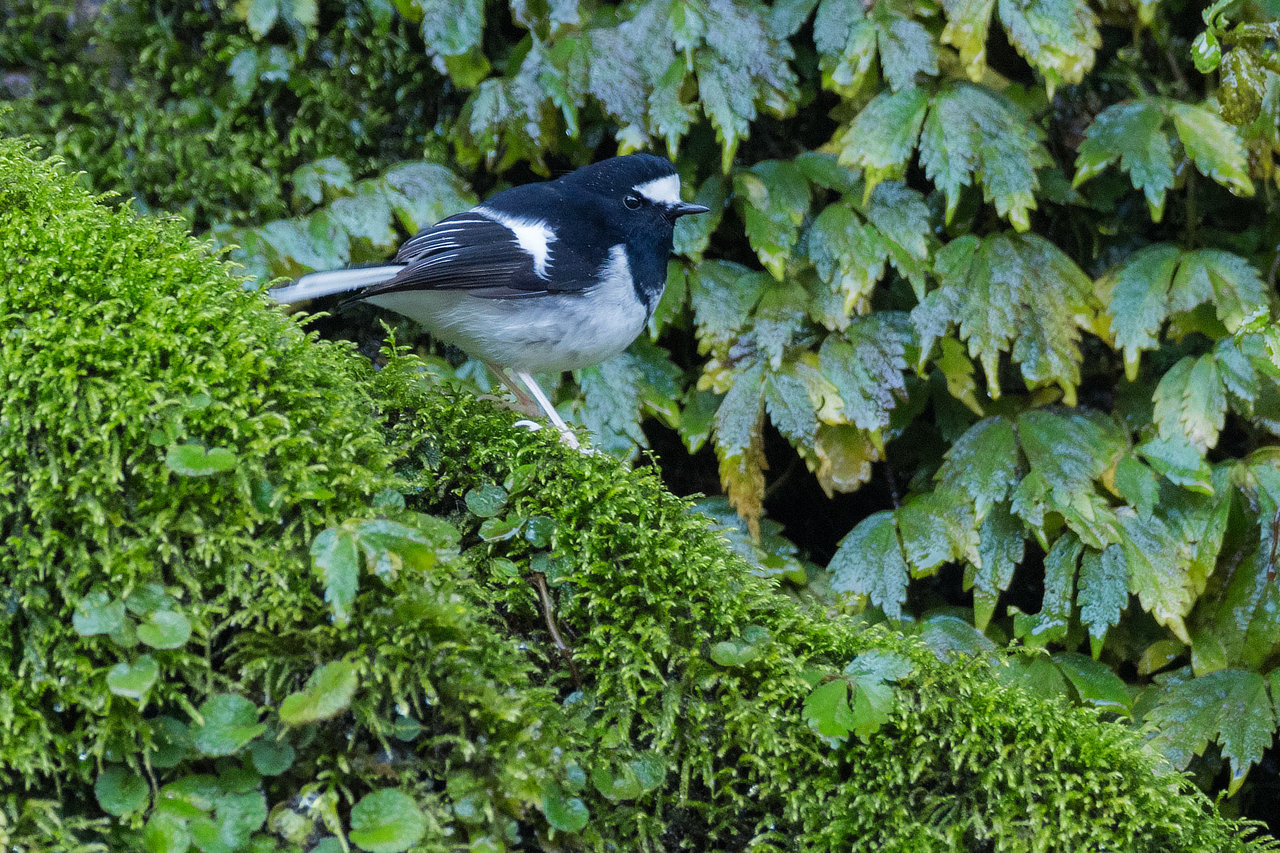
DAY 12: TINGTIBI TO GELEPHU
We will start early to bird in the lower Tamala region at 1,660 meters elevation. Our target birds for this morning include the Near-Threatened Rusty-bellied Shortwing (rare), Red-faced Liocichla, and the rare Yellow-rumped Honeyguide. Leaving Tamala, we descend through mixed temperate forests to the prosperous Surrey village. Birds we hope to see include Wreathed Hornbill, Spotted Forktail, Scarlet Minivet, Common Green-Magpie, Blue Rock-Thrush, and Golden-fronted Leafbird. Arriving in Gelephu, we will search for Black-hooded Oriole, Black-naped Monarch, Orange-breasted Green-Pigeon, Large-tailed Nightjar, and Pied Bushchat. Gelephu also offers us the best opportunity to see some of the Himalayan owls – Spotted Owlet, Brown Boobook, Oriental Scops-Owl, and perhaps the even rarer Oriental Bay-Owl may be found after dark! Overnight in Gelephu.
DAY 13: GELEPHU TO TSIRANG
We will spend most of the morning birding at the Gelephu sewage treatment plant, seeking out birds such as Indian Peafowl, Jerdon’s Baza, Brahminy Kite, Black Stork, Asian Openbill, Pin-tailed Snipe, Little Grebe, Pied Kingfisher, Yellow-footed Green-Pigeon, Cinnamon Bittern, Greater Flameback, and Coppersmith Barbet. From the sewage pond we continue to Sarpang, where we will look for the colorful Indian Roller, as well as Fulvous-breasted Woodpecker, Dollarbird, Greater Racket-tailed Drongo, and more. We will gradually make our way to Tsirang, and along the way we hope to see include Long-billed Wren-Babbler, Streak-breasted Scimitar-Babbler, and Brown Wood-Owl, along with many other common birds. Overnight in Tsirang.
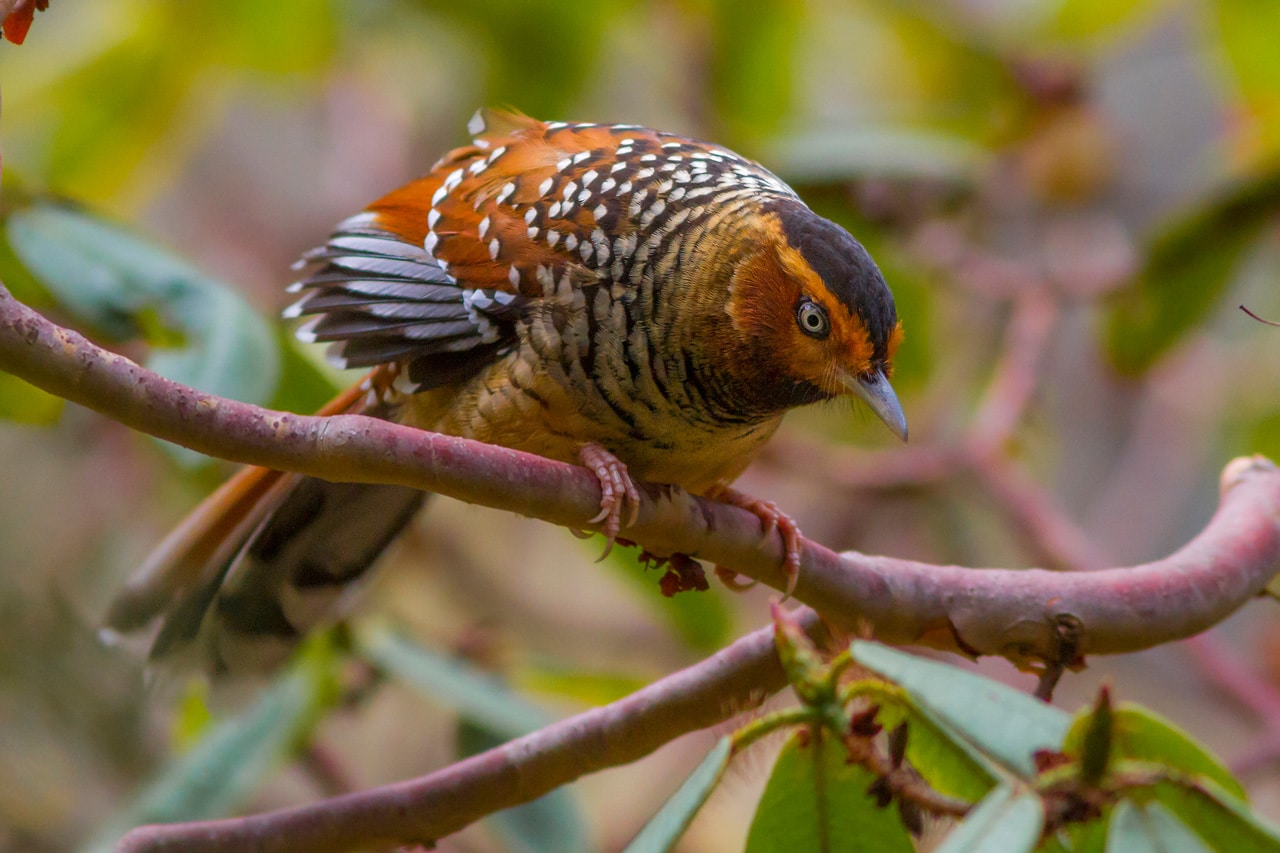
DAY 14: DAMPHU TO PARO
This morning we will bird our way down to Sunkosh valley, lookin for one of the rarest birds in the world, the Critically Endangered White-bellied Heron. Other regular birds we hope to see include Greater Flameback, Blue-throated Barbet, Velvet-fronted Nuthatch, and Long-tailed Minivet. Arriving at Wangdue we will continue to Paro, stopping for birds as time allows. Overnight in Paro.
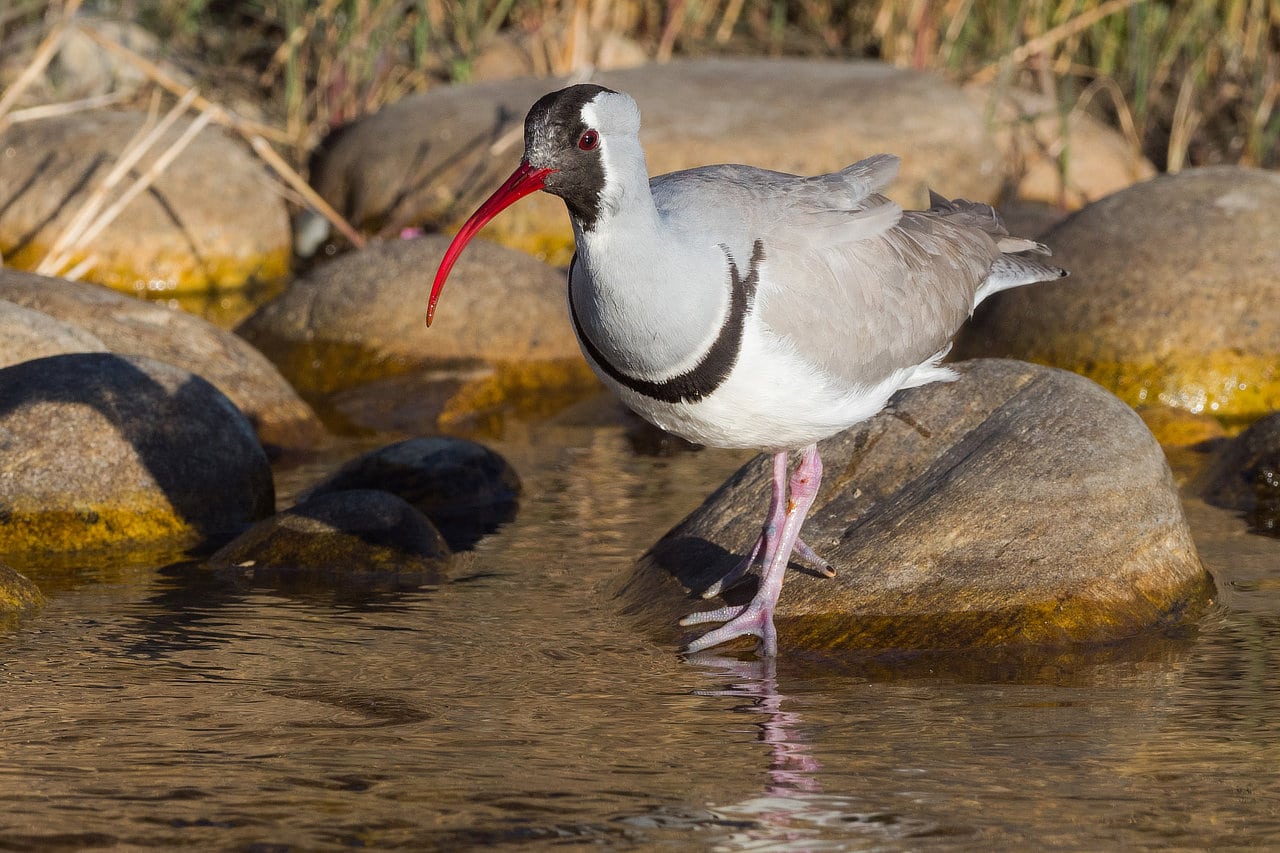
DAY 15: CHELE LA PASS
An early morning departure for our journey up through ancient pine and fir forests to Chele La Pass (3,780 m), where there are fantastic views of the high Himalayan peaks. Chele La gives us the opportunity to ascend above the treeline into alpine meadows and dwarf Rhododendron scrub, here we have the possibility to find the beautiful Himalayan Monal, Blood Pheasant, White-collared Blackbird, Rufous-breasted Accentor, and the beautifully colored Himalayan White-browed Rosefinch. We will continue birding in this beautiful area before gradually making our way back to Paro town for some leisurely time, followed by dinner. Overnight in Paro.
DAY 16: DEPARTURE
After breakfast, we will transfer to the airport in Paro for our departure flights.
Our Bhutan birding tour concludes in Paro.
Species
BIRDS
- Greater Adjutant
- Himalayan Griffon
- Pied Harrier
- Snow Partridge
- Hill Partridge
- Chestnut-breasted Partridge
- Blood Pheasant
- Satyr Tragopan
- Himalayan Monal
- Kalij Pheasant
- Gray Peacock-Pheasant
- Black-tailed Crake
- Ibisbill
- Emerald Dove
- Pin-tailed Pigeon
- Violet Cuckoo
- Himalayan Cuckoo
- Green-billed Malkoha
- Tawny Fish-Owl
- Large-tailed Nightjar
- Red-necked Trogon
- Ward’s Trogon
- Blue-bearded Bee-eater
- Rufous-necked Hornbill
- Great Hornbill
- Wreathed Hornbill
- Blue-eared Barbet
- Yellow-rumped Honeyguide
- White-browed Piculet
- Rufous Woodpecker
- Long-tailed Broadbill
- Hooded Pitta
- Rosy Pipit
- Long-tailed Minivet
- Ashy Bulbul
- Golden-fronted Leafbird
- Brown Dipper
- Alpine Accentor
- Black-faced Warbler
- Brown-throated Fulvetta
- Great Parrotbill
- Blue Whistling Thrush
- Gould’s Shortwing
- Large Niltava
- Blue-fronted Redstart
- White-capped Water Redstart
- Black-backed Forktail
- Little Forktail
- Indian Paradise Flycatcher
- Rufous-necked Laughingthrush
- Spotted Laughingthrush
- Bhutan Laughingthrush (near-endemic)
- Himalayan Cutia
- Rufous-winged Fulvetta
- Coral-billed Scimitar Babbler
- Rufous-throated Wren-Babbler
- Golden Babbler
- Black-eared Shrike Babbler
- Fire-tailed Myzornis
- Whiskered Yuhina
- Beautiful Nuthatch
- Gould’s Sunbird
- Fire-tailed Sunbird
- Crimson Sunbird
- Maroon Oriole
- Lesser Racket-tailed Drongo
- Gray Treepie
- White-browed Rosefinch
- Yellow-breasted Greenfinch
- Spot-winged Grosbeak
MAMMALS
- Golden Leaf Monkey (Langur)
- Red Panda
- Leopard
- Leopard Cat
- Bengal Tiger
- Musk Deer
TOUR BASICS
Guide: Yeray Seminario
Single Supplement: US$575
Lodging: Comfortable hotels and nature resorts
Food: Fresh, traditional cuisine
Weather: Wide range of temperatures as we move through different elevations, from highs around 30C in the lowlands to freezing (0C) at night in the high Himalayan passes.
Difficulty: Easy to medium. Average elevation for this tour is 2400m (7800 ft.) and we will reach passes up to 4000m (13000 ft.) with windy mountain roads and some uneven trail conditions. Most birding is done on main roads.
* Pricing is based on a minimum of 6 participants. With smaller groups, an additional fee will be charged.
LEARN MORE
Upcoming tour dates:
April 12-27, 2025
Past trip reports:
2023 Bhutan Tour eBird Trip Report
From our blog:
Top 10 Birds to See in Bhutan
Notes from Bhutan: Pre-tour Visit Highlights
Our Newest Destination: BHUTAN
Hornbills & Toucans: A Tale of Convergent Evolution
